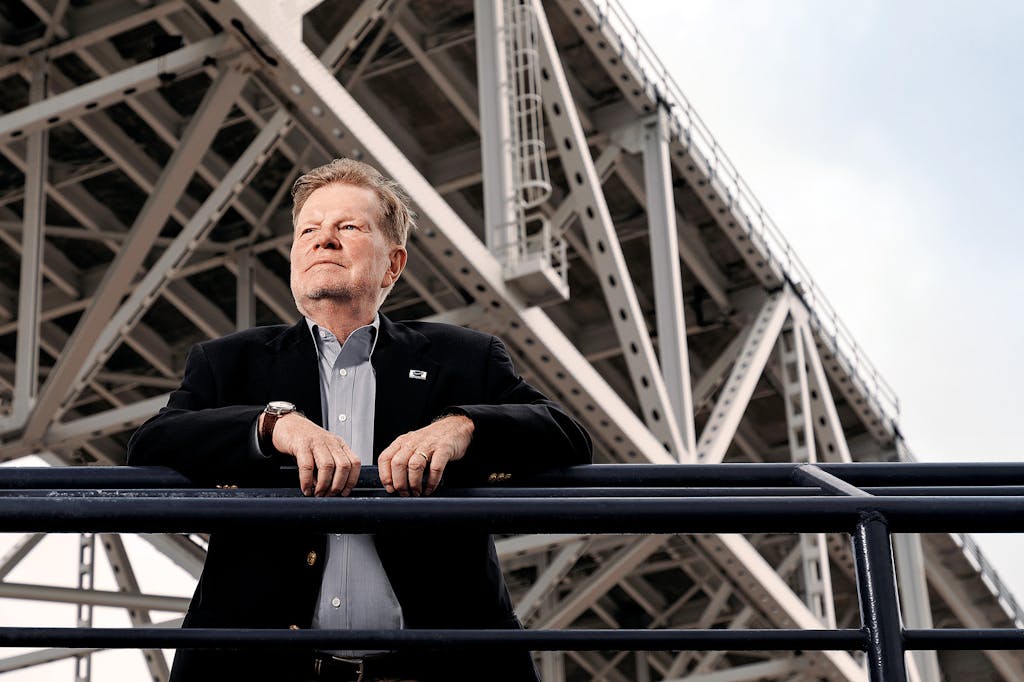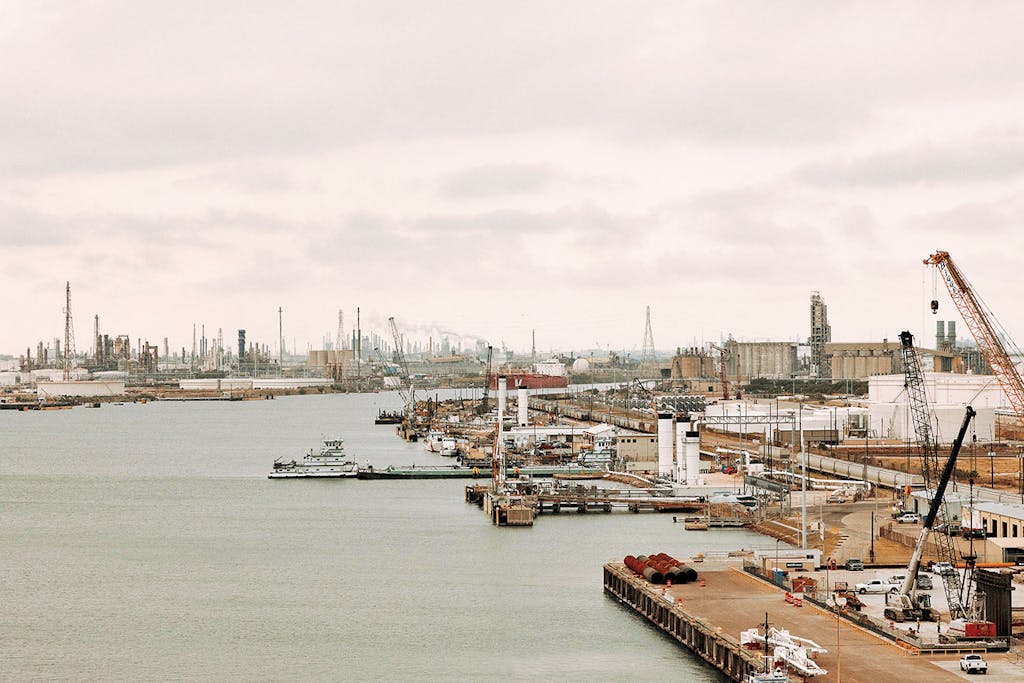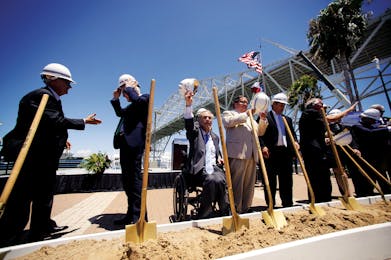This article originally appeared in the September 2017 issue of Texas Monthly with the headline “Oil and Water.”
One Shoreline Plaza, in downtown Corpus Christi, provides an impressive view of the city’s coastline. On a recent Friday afternoon, Iain Vasey sat in his thirteenth-floor office, talking about the billions of dollars of foreign investment funneling into the other side of the bay. Then his assistant popped in. “Did you see that?” she asked.
Vasey had not. He stood up from his chair and walked to his window just in time to see a black four-rotor drone, about the size of a pizza box, suddenly appear a few feet away. It hovered there, swaying slightly like a pendulum. Vasey watched it for a moment, but his attention quickly shifted to the palm trees below and the glistening waters of the bay. “Who wouldn’t want to wake up to this every day?” he asked.
Vasey, who came to Corpus from Baton Rouge, was hired as president of the Corpus Christi Regional Economic Development Corporation to help guide the city through its current boom—$50 billion in industrial investment from domestic and international companies hoping to cash in on cheap natural gas from the Eagle Ford Shale. But in the two years he’s been in Corpus, he’s fallen for the city’s grit and charm. When he dies, he’s hoping for something like a Viking funeral on the water, his body laid out on a wrecked ship set afire by a flaming arrow, while his friends drink beer on the shore.
Corpus is the type of place where such a thing feels possible, and from his bayfront office, Vasey can see just about everything the city has to offer. To the south, Shoreline Boulevard leads past the hotels, the marinas, the T-head pleasure piers, and the Whataburger by the Bay, before the road gives way to Ocean Drive, curving along the coast, past the naval station and the Army depot, until there’s nowhere left to go but the Gulf. To the north, across the Harbor Bridge, are the new industrial complexes that fuel the other side of the city’s economy.
For much of its history, Corpus has remained a town of unrealized potential largely because of its shallow bay. In 1890, a New Jersey land speculator promised to turn Corpus into the “Chicago of the Southwest” by building a deepwater port, but a national depression stalled those plans. The federal government completed the first dredging, in 1926, and officially established the port, but the ship channel remained relatively narrow and shallow until a digging project in the sixties allowed larger tankers to pass. Until recent years, most of the work at the port had revolved around importing oil for three local refineries.

The city has watched as the nearby Eagle Ford Shale, discovered nine years ago by Corpus Christi geologist Gregg Robertson, transformed South Texas. The windfall never quite reached Corpus.
But at the end of 2015, not long after Vasey was hired, the federal government lifted a wide-ranging forty-year ban on crude oil exports in order to take advantage of the sudden abundance of shale oil. Since then, Corpus has quietly become the nation’s leading oil exporter. To ensure that won’t change anytime soon, a new pipeline project was launched this spring to move close to half a million barrels of crude a day from the Permian Basin to the Port of Corpus Christi.
Vasey predicts that the new port developments will produce between 10,000 and 20,000 high-paying industrial jobs, with a ripple effect of another 30,000 or so jobs in retail and service sectors. “We’re actively in competition for another twentysomething projects right now, somewhere north of twenty billion dollars’ worth of investments,” Vasey said as he watched the black drone zip down the side of the building and disappear over downtown. “That would transform this city again.”
There’s not much about John LaRue that says “sea dog.” Among the knickknacks in his office are three porcelain beer steins that feature the faces of old British admirals. His wife bought the mugs at an estate sale because she thought he needed something nautical to display. Otherwise, his walls are filled with the congratulatory plaques of a chamber of commerce leader. That’s because his job is not to sail any ships but to oversee the six thousand tankers and barges that pass through the port every year.
As the Port of Corpus Christi executive director, LaRue manages more than 1,300 acres of industrial property along the northern edge of the bay, along with its inner harbor, which drains into the Nueces River. The area is a mass of import terminals for the city’s refineries, with crude tankers at the docks. Agriculture products, like wheat and sorghum, move through the port too, along with aircraft engines, wind turbines, and steel.
From his office, LaRue points out the tower of an Austrian-owned steel plant that recently wrapped up construction. The $1.2 billion complex will import iron ore from Brazil and Sweden and use Texas natural gas to superheat it to more than 1,000 degrees, burning off the impurities and producing small bricks that are almost pure iron. The briquettes will ship to European car manufacturers—Audi and Mercedes and BMW—many of which will return as vehicles for sale in the United States. “It’s part of the logistics of the world,” LaRue says.
A native of Pennsylvania, LaRue had run the Port of Philadelphia before he took the job in Corpus two decades ago. For much of his tenure, 60 to 70 percent of the port’s revenue came from the Koch Industries, Citgo, and Valero refinery complexes. By next year, however, LaRue says the refineries will account for less than a third of revenue. Most of it, he says, will come from selling and shipping shale oil.

When Congress lifted the export ban two years ago, the Port of Corpus Christi was an obvious choice to start exporting the glut of Texas oil to the rest of the world.The city was close to the source and in good standing under federal clean-air regulations, so obtaining air-quality permits for new construction was easier than at other Gulf Coast locations. And, unlike at Houston or Louisiana ports, ship traffic here was low enough to take on a sudden influx of new tankers.
On New Year’s Eve 2015, LaRue, Vasey, and other local officials went to the NuStar Energy dock to watch the first shipment leave Corpus. The crude oil tanker Theo T, loaded with 600,000 barrels of Eagle Ford crude, pulled out of port at 4:30 p.m., destined for Europe. “Now we could compete anywhere in the world,” LaRue says. “We have crude going out of here to Asia, going to Europe, going to South America. The volumes have just steadily increased.”
In 2016, crude oil exports from Corpus Christi totaled 148,000 barrels a day, but by the first quarter of this year, the port was exporting 316,000 barrels a day, as much as Beaumont, Port Arthur, and all Louisiana ports combined. The daily oil exports from Houston, Texas City, and Galveston are roughly a tenth of what is leaving Corpus.
When the price of oil fell dramatically in 2014, the number of active drilling rigs in the Permian Basin and Eagle Ford Shale dropped with it, from 905 that November to just 340 a year later. By May of 2016, fewer than 200 rigs were active in Texas. But production didn’t decline, and, according to the U.S. Energy Information Administration, the state has continued to produce more than 3 million barrels of oil a day, levels not realized since the wildcatting days of the seventies. A proposed pipeline called EPIC (Eagle Ford, Permian, Ingleside, Corpus Christi) is expected to start shipping Permian oil, along with some from the Eagle Ford, by the first quarter of 2019, ultimately reaching a capacity of 600,000 barrels heading to the port every day. Karr Ingham, an economist with the Texas Alliance of Energy Producers, says the investments being made now by oil and pipeline companies and exporters are based on the long view. “[Corpus Christi] is going to be a player in a big way in the years to come,” he says.
The Texas Department of Transportation also plans to replace the city’s Harbor Bridge over the next four years, at a cost of $800 million, so larger ships can enter the port’s inner harbor. The new bridge, currently under construction, will have a clearance of 205 feet—enough to allow the tallest tankers in the world to pass—and will run two and a half miles end to end, making it the longest cable-stayed bridge in the country. Port officials also decided to pony up $35 million to start expanding the ship channel, despite the Corps of Engineers’ repeated delays in appropriating necessary additional funds.
Perhaps no entity, public or private, is betting on Corpus as much as Houston-based Occidental Petroleum Corporation, which controls the massive Ingleside Energy Center on the north side of the bay. Occidental is the largest producer in the Permian Basin, and soon after the EPIC pipeline comes online, the company expects to double its production. “The refinery complexes are basically saturated with light crude,” says Cynthia Walker, a senior vice president at Occidental. “It needs to find its way to water.”

On May 26, eight miles out from Port Aransas in the predawn darkness, a pilot boat bounced across five-foot waves toward the Anne, an 1,100-foot very large crude carrier (VLCC) waiting to be brought into port. It would be the largest ship ever to dock in the city—in fact, the largest oil tanker brought to berth in any Gulf harbor. The Anne is 200 feet longer than the U.S.S. Lexington, the World War II aircraft carrier that now serves as a floating museum in Corpus Christi Bay. Stood on its end, the ship would be taller than any building in Texas. When the Anne is full, she holds more than two million barrels of crude oil, but on this day, she was empty.
For the harbor pilots charged with bringing the Anne to port, this wasn’t just an academic exercise. In January, a smaller bulk carrier lost engine power as it approached the Port Aransas ferry terminals and began drifting toward the rock jetties. The harbor pilot saved the ship by using its anchors and currents to berth it against the south side of the channel, where repairs were made. But the episode was a lesson in how quickly the commonplace can become a potential disaster, and much of Corpus Christi’s economic future was riding on the Anne making it safely to the Ingleside dock.
In the months before the Anne’s arrival, Captain Jay Rivera and three other pilots had trained on a massive simulator in Houston. But the simulation couldn’t prepare Rivera for the sight of the Anne as his pilot boat pulled up next to her at about 5 a.m. Rivera stepped across to a rope ladder hanging from the Anne’s main deck, climbed five rungs, and then moved over to a partially lowered gangway. “After I climbed up about a hundred steps to get up on the main deck, I really realized how big this thing was,” he says. “After I got on the main deck, we had to continue climbing another ten flights of stairs to get on the bridge.” Once there, Rivera consulted with the French captain, had him practice some maneuvers, and, at first light, three more Corpus harbor pilots joined him aboard. Five tugboats tethered themselves to the ship like guardian angels.
With fellow pilots serving as his eyes and another at his side to make certain his orders were carried out, Rivera guided the Anne past the Port Aransas jetties as tourists and fishermen waved a welcome. The tugs pushed her up against the dock shortly before 8 a.m. Massive U.S. and Texas flags flapped over her side. “It went like clockwork,” Rivera says .
Large supertankers, like the Anne, are the most efficient way to transport oil to Europe and Asia. At present, though, the only way to fill them on the Texas coast is by using smaller tankers to ferry oil from the port to deeper waters. That requires three to four ships and takes ten to twelve days. But by pulling a ship the size of the Anne to the Ingleside dock, Occidental could put 1.2 million barrels of oil in the hold in a single day. If the Corpus ship channel is deepened, Walker says, several hundred thousand additional barrels of oil could be loaded at the dock, lessening the ocean-side transfer even more. “Every day is economics,” she said. “So it is meaningful.”
The Anne’s owner, Belgian shipping company Euronav, charters its supertankers to oil companies for an average of $29,000 to $51,000 a day, depending on the time of year. Occidental estimates that the Ingleside loading procedure would save 75 cents a barrel in transportation costs, or roughly $1.5 million for each tanker filled with oil.
The Anne’s successful dry run into Corpus Christi Bay made port officials and Occidental comfortable enough to gear up for another ship of her size. Over the next year, new loading arms will be designed and built so that the port is ready to transfer oil onto the next supertanker that arrives, in late 2018 or early 2019. Waiting a year for the next big tanker feels like a lifetime compared with the speed at which booms can turn into busts, but a Texas oil boom has never involved floating skyscrapers moving along the coast. “When you talk about boom, that kind of implies it’s a flash and then it goes away,” says Vasey. “This is a long-term strategy, almost a structural shift that the economy is going through. It’s the next wave of the shale revolution.”







